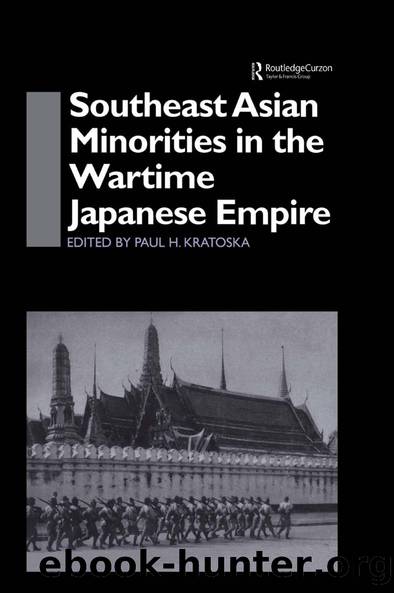Southeast Asian Minorities in the Wartime Japanese Empire by Paul H. Kratoska

Author:Paul H. Kratoska [Kratoska, Paul H.]
Language: eng
Format: epub
ISBN: 9780415515306
Barnesnoble:
Publisher: Taylor & Francis
Published: 2012-06-22T00:00:00+00:00
Natives and other Local Communities
The Epitaph for the Kinabalu Guerilla Movement Martyrs engraved on the monument in the Petagas Memorial Garden states that âa patriotic youth named Albert Kwok organized an underground guerilla force to which more than 300 young men from various communities in the State were recruitedâ. The monument records the names of 323 Chinese (of whom 205 were killed in Api and 118 in Labuan) and 66 non-Chinese martyrs (natives and Indians).
According to Western sources, in addition to Jules P. Stephens and the leaders from the offshore islands mentioned above, several other community leaders such as Musah (a Dusun), Duallis (a Murut), Subedar Dewa Singh (an Indian constable) and Charles Peter (a Eurasian) participated in the revolt from the outset. Musah, a well known rebel against Britain prior to Japanese rule, was subsequently arrested by the JMA and died in prison. Duallis remained active in the anti-Japanese guerrilla movement throughout the Occupation. Charles Peter, a member of the NBVF, was executed on the same day as Kwok.62 Dewa Singh, together with more than thirty other Indian constables who failed to support Japan when the revolt took place, was taken to Kuching and enrolled in the Indian National Army.63 A number of Dusun constables who betrayed the JMA were executed.64
The way non-Chinese participants in the rebellion are portrayed in local and foreign Chinese-language sources has changed over time. The North Borneo Yearbook published in Api in 1952 states that, unlike other natives, Sulus were strongly disposed to be anti-Japanese due to the influence of the US, and for this reason established a close relationship with Lim Keng Fatt.65 The Southseas Yearbook published in Singapore in 1951 says that some Dusuns, including the penghulu (village head) of Menggatal joined the KGF,66 while books on Malayan Chinese history published in Taipei in 1963 and in Hong Kong in 1967 also note that Dusuns led either by the penghulus or by the zhishi (the brave ones) joined the guerrillas at an early date.67 However, these sources do not name any non-Chinese Sabahan leaders in the KGF, and say nothing about the involvement of members of other native communities. Only the number of the victims from these groups appears in these Chinese books. On Gaya Island, â50 to 60 people were killed . . . [while] elsewhere 20 natives and 400 Sulus were killedâ.68 And, âMore than one hundred KGF members and several hundred Dusuns were confined in the Api prison. Only 13 of them survived the occupation.â69 It is impossible to know whether these people were active members of the KGF or merely supported the revolt.
More recent accounts of the uprising have given greater recognition to non-Chinese participants. Liu Zhi Yuan recalled in 1971 that the uprising was received enthusiastically, and that fraternal ethnic communities offered cooperation and support.70 And in his reminiscences, published in 1978, Chia Yik Teck not only recorded the names of all the non-Chinese martyrs engraved on the monument, but also referred to Charles Peter as a guerrilla leader and mentioned 20 native members of the KGF in Kota Belud.
Download
This site does not store any files on its server. We only index and link to content provided by other sites. Please contact the content providers to delete copyright contents if any and email us, we'll remove relevant links or contents immediately.
Spell It Out by David Crystal(35861)
Life for Me Ain't Been No Crystal Stair by Susan Sheehan(35548)
Cecilia; Or, Memoirs of an Heiress — Volume 1 by Fanny Burney(32088)
Cecilia; Or, Memoirs of an Heiress — Volume 3 by Fanny Burney(31478)
Cecilia; Or, Memoirs of an Heiress — Volume 2 by Fanny Burney(31432)
The Great Music City by Andrea Baker(30929)
Professional Troublemaker by Luvvie Ajayi Jones(29439)
We're Going to Need More Wine by Gabrielle Union(18658)
Twilight of the Idols With the Antichrist and Ecce Homo by Friedrich Nietzsche(18314)
The Secret History by Donna Tartt(18259)
All the Missing Girls by Megan Miranda(14840)
Cat's cradle by Kurt Vonnegut(14800)
Pimp by Iceberg Slim(13825)
Bombshells: Glamour Girls of a Lifetime by Sullivan Steve(13714)
Fifty Shades Freed by E L James(12935)
Talking to Strangers by Malcolm Gladwell(12912)
Norse Mythology by Gaiman Neil(12875)
The Social Justice Warrior Handbook by Lisa De Pasquale(11967)
Underground: A Human History of the Worlds Beneath Our Feet by Will Hunt(11855)
